Want to plug your guitar into an iPad so you can carry around a giant pedalboard in your pocket virtually? You’ll need an interface of some sort. When I started this journey, I thought I had done my due diligence, as I thought that this stuff was at least on par with the hobby level electronics for the desktop.
Most of it isn’t.
The community doesn’t expect it to be and the manufacturers don’t for the most part seem to care about real world performance. I am going to try to make the guide I wish I had when I started this, and hopefully it will help you avoid mistakes and pitfalls I fell prey to. I thought I had read all the necessary “reviews” when I started this, as there were even web pages devoted to this subject. Some of them were obvious nonsense, but some seemed well intentioned. I made too many assumptions that these sites would have screamed from the hills if the very basics were broken, but I was wrong. Really wrong. I intend for this to be actually useful to using the devices for their intended purposes.
I will add devices as I receive units to test. For manufacturers, most of you already know from our time together on desktop devices that I will most happily accept products for review, and in that case, I will submit my findings to you before posting so you have a chance to comment or set me straight on any issues I have, but as always, I WILL report the truth as I see it. I welcome your participation, but I want to reiterate the risk you are taking that I may give your product a bad review.
TL;DR – here we go.
I tried to get a really good look at these things to see basically what sorts of ins and outs they have…Even pictures are a bit difficult to track down sometimes, and most of the questions you would think to ask when looking for this sort of thing aren’t really available. Contacting the manufacturers was sometimes helpful in clarifying things.
Apogee
Apogee’s Jam line of products seem like they would have been cool back before the lightning audio days. As far as I can tell, they don’t have any actual outputs, instead relying on the mobile device to provide the audio output. I think this is a non starter for our purposes, and won’t be saying any more about these as far as I know.
Verdict: No thanks
ONE/ Duet/ Quartet

Apogee is an enigma, they were really early to jump into the digital game, when there were still significant (and actually audible) problems with digital recording. We got their early filters for our Mitsubishi ProDigi format machines and it was a difference we could not only measure, but made a big difference in typical day to day stuff like setting compressor thresholds. That bit of splat, that I think George Massenburg assured us was group delay, made compressors for instance react to a different level than the one we apparently heard. Technobabble aside, it was a huge improvement. Later we would go on to get their analog to digital converters to replace the front end of the early tape based digital machines like our Sony PCM3348’s and later as front ends to the Modular Digital Multitracks (ADATs and DA-88’s for instance). They took a lot of first steps and really worked out how ADCs and DACs would work in a multitrack environment.
And then the computers came. The MDM style products still made great converters for the budding multichannel audio interface market, but Apogee decided to make their own. Way early to the digital party, and way late to the interface party, Apogee priced about on par with their name and reputation (the same way Focusrite did, although Focusrite having already established varying lines for varying budgets in the pre computer days, did the same on the DAW side as well), but their drivers and implementation were nowhere near as mature as even the “budget” companies’ offerings. As a predictable result, sending products to market before many of those who needed to be in the loop had a chance to test them, Apogee released some sound cards (and yeah, I will happily use that term interchangeably with “audio interface”, sue me) that absolutely tanked. Apogee was bit hard coming up short against the ASIO wall, and on this market, they never really seemed to recover and went off to hide in the Mac world.
Lucky for us! That means that some of the more desktop style I/O’s are available for iOS, where there is less chance of incompatible hardware, making it a lot easier to build for, and no pesky ASIO
Like the similar Presonus and Focusrite models, the Apogee Duet and Quartet are dual use dektop and mobile. Unlike those however, they are Mac side only and not Windows (I did see some press announcement that finally, Apogee have joined the 21st century and as of November, should have some Windows drivers, not holding my breath and given Apogee’s track record, would wait about 6 months of ASIO success before really being able to recommend these for that use).
As a harbinger of things to come, the ONE makes the untrue claim right out of the gate, and I quote from the website “The only interface that charges iOS devices while in use and can also be battery powered.” Sorry, there are other interfaces that can meet both requirements (and ones that don’t NEED to be battery powered as well). On the other hand, this is certainly a contender. Stereo ins on a breakout box, 1/8″ headphone out, a bit of metering, power input and also doubles as a USB interface for Mac desktop, and maybe someday, Windows…more on that below.
The Duet has two inputs and four outputs, which could possibly, through some tricky use of Audiobus or other routing solutions, help to deal with some of the routing issues in our existing iOS guitar software. It also has MIDI over USB. It also claims desktop level +20dBu outputs! Yowza! I have read that it offers pass thru charging to the iDevice as well. Which also brings up the point that this device needs a power supply to work with the mobile gear. Something I don’t see mentioned enough is its handy, multifunction knob for setting in and out levels. Very large, clear and seems to be made in a way that you don’t need to duct tape the knobs in place like some of the other devices…cool! Like the iRig pro, the inputs are Neutrik style Combo connectors, nice! The Duet also has some seriously serious looking metering.
The Quartet ups the ante on the Duet offering 4 Combos in and 6 1/4″ out….All separate, REAL connectors, VERY nice! Again serious metering here as well. Something else I don’t think I’ve seen on any other of these devices: 8 ins and outs over ADAT! This brings the Quartet up to the level of the type of product you can find on Craigslist of 50 dollar desktop interfaces, but on the mobile platform. Something comfortable, something familiar! Like a beacon in a storm almost.
The Verdict: These three devices offer some cool features, some with unique features, but they have their issues as well. The ONE and the Duet have their I/O on breakout boxes, adding to the unreliability (but then again, potentially fixable in ways the internal connectors of other devices may not be), not sure the availability of replacement cables, and this could lessen their perceived portability and add a tiny bit of complexity. Is it worth it? Up to you. Cutting down on the portability as well are the power requirements. The ONE seems to need batteries like the iRig Pro series, again, this may or may not be an issue to you. The Duet and Quartet have the same pluses and minuses as the other desktop style interfaces reviewed here, with the extreme disadvantage that the others have stable, mature ASIO drivers for Windows, while at this time these devices are Mac only on the desktop side. Entire forums have been shut down arguing over converter quality between Apogee Lavry, Mytek and all the budget converters, so I won’t really go into that here although, I would be willing to do one of my notorious bets that you won’t be able to pick the apogee in an ABX over the Presonus or Focusrite. I would happily put up some gear for that challenge. Because of this, for the cost of the Apogee, I would buy two of the arguably more functional desktop style interfaces from Presonus or Focusrite and have some money left over for a Blueboard or BT-4, before I bought one of these two units. The ONE may be more of a contender if you don’t mind the power requirements and the breakout cables VS the comparable iRig stuff
Behringer
iS202

This device is a docking style interface with a really comprehensive looking set of inputs and outputs. It also seems to have pass through charging. Unfortunately, I think it is only for older devices. It was unclear to me if there is a lightning connector version.
Verdict: Probably pretty cool in its day, and probably still cool for the devices it supports, but without lightning support, this feels like an evolutionary dead end.
Focusrite
iTrack One Pre/ iTrack Pocket


These two lightning devices, like the Apogee Jam series, don’t seem to have any outputs of their own. They are probably great for older devices, but I wouldn’t be too interested in them for stage duty.
iTrack Dock


Now we’re talking! Lightning connector, real, separate 1/4″ outputs, and separate physical gain controls where you need them. Microphone inputs, should you need them, USB MIDI of some sort and a claimed +10dBu out! Yes!
You give up a little in the way of convenience and portability in that you need to supply A/C to the Dock’s power supply, but on the plus side, this guy has pass thru power and charges your iPad while its docked!
I need to give one of these a real test and see if that need for a power supply is really any issue in real use.
iTrack Solo

This is a bit of a different beast, as it is also a Mac/Windows USB audio interfaces, as well as an iOS interface. With Focusrite, this means pretty mature, reliable, and confidence building ASIO drivers. Quite cool to be able to use the same device for your “real” DAW and your iGuitar duties.
While this device does have separate left right outputs, they are on [YUK!] RCA jacks. There also is a stereo Headphone out, thankfully on 1/4″.
If you are using this with an iPad, as with the iTrack Dock, you’ll need to power it. In this case it has a USB port for charging, might be able to use one of those portable power brick battery things. Unfortunately, if I am reading the manual correctly, this device will not pass through the power and charge your iPad.
Verdict: For my money, the iTrack Dock seems to be the best way to go from the Focusrite offerings. I’m swimming in multichannel ASIO audio interfaces, so the dual nature of the Solo isn’t really a seller for me, but for others it well could be. Pass thru power, a plethora of 1/4″ outputs, and pass thru charging tilt the scales way in the favor of the Dock
Griffin
GuitarConnect Cable
 If you have to, I guess….Analog connection through your iDevice’s headphone jack, so no lighting only newer devices. You’d probably be better off with one of the analog iRigs.
If you have to, I guess….Analog connection through your iDevice’s headphone jack, so no lighting only newer devices. You’d probably be better off with one of the analog iRigs.
GuitarConnect Pro
Like the Apogee stuff, there doesn’t seem to be any outputs on this thing, but it looks like it works with lightning, USB and 30 pin devices. I guess if you have an older device, this could be OK…Its not much cheaper than an iRig HD though, which seems (still working through an iRig issue with IK’s tech support) to be much better on paper, and definitely has some outputs. I wouldn’t recommend this product.
StudioConnect
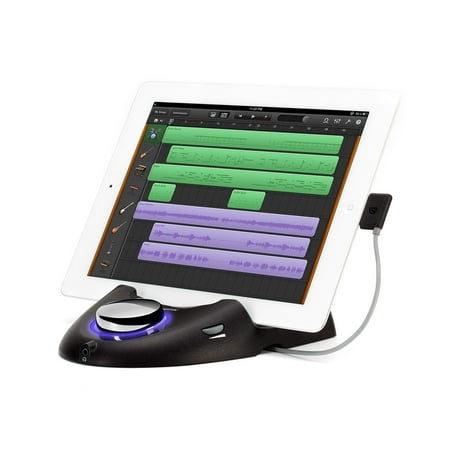
Seems to be 30 pin only, what a bummer, as it has a full set of ins and outs including MIDI. According to an article at Premier Guitar, there’s supposed to be a lightning version of this, but that was 2013, and I see nothing about it at Griffin’s website
IK Multimedia
iRig 2
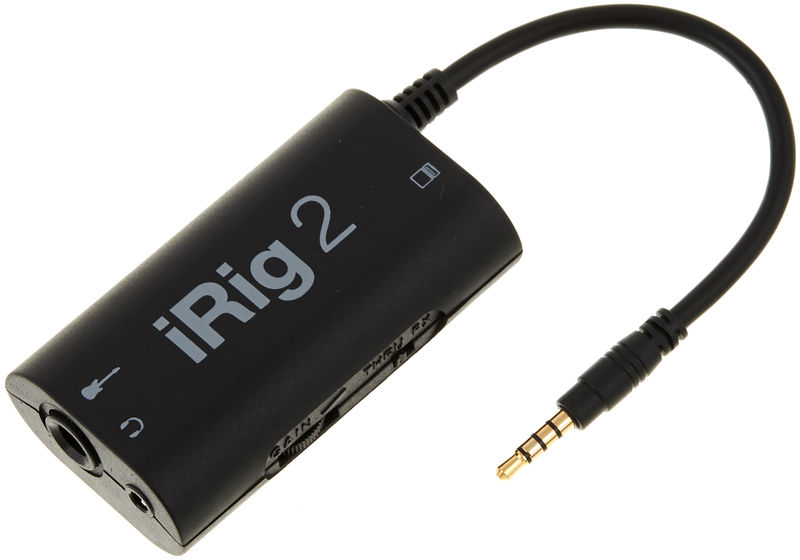
A newer incarnation of the device that seems to have started it all. Chances are the whole reason you are looking at any of this, comes from IK Multimedia’s early work. I was blown away back in the day at a NAMM show watching people walking around with an entire guitar amp and FX system on their phones! That was the kind of future tech that you could respond to the ever present question “come on man, where’s my flying car already?”. Unfortunately, for some reason, not all that much has changed since then for IK’s software, which had once led the pack, and still a KILLER contender on the desktop, just isn’t much on the iPad. If you are looking for Amplitube on the iDevices, look at Tonestack, it has its own issues and shortcomings, but its as close to Amplitube VST as you are going to get on the iOS system.
Still, IK are the pioneers and we have a lot to thank them for in the mobile world.
The iRig 2 is the newest incarnation of their original devices, utilizing the headphone/mic jack on the older iThings as the I/O. This makes things a little iffy with noise and especially, feedback issues. Some software will allow an anti-feedback mode to use with this style of interface, but that makes it mono, killing the ability to run The One True Path (a signal with no cab sim for the guitar amp and a signal with a cabinet simulator on for the PA system).
This particular unit has a 1/4″ output (but it is summed to mono as far as I can tell) and a stereo 1/8″ headphone out.
For historical reasons, I figured this unit needed to be on the list, as it is the modern presentation of a legacy, but unless you have an older device that can’t do lightning, I would definitely avoid this model.
iRig HD 2

Here we are with a modern, lightning interface from IK Multimedia. Personally, I feel this unit sounds MILES above the iRig 2, especially up high in the treble department. To me, the difference was stunning. And that is nothing compared to the noise and lack of feedback problems! Perfect, right?
Well, maybe, or maybe not so much.
I started getting horrendous noises and distortions when clicking on menus or sometimes, even at random. Initially, in communication with IK’s tech support, they sure made it seem like they hadn’t seen this problem before, but it wasn’t too long before I found forum posts explaining it and the problems, and finally, at the end IK spilled the beans. This device shouldn’t be used with the older devices, as something broke in OS 10 or so….Not IK’s fault, and the prevailing wisdom is that Apple is aware of this problem, but probably won’t be fixing it…Indeed, it has gone on so long that the time for fixing was a few generations ago, so that’s probably true.
http://cgi.ikmultimedia.com/ikforum/viewtopic.php?f=9&t=12867
Still, there should be a BIG FAT warning in giant letters at IK’s site warning of incompatibilities with this model and older devices. I believe it behooves any manufacturer to think of their customers this way. IK didn’t so I will
DO NOT BUY THIS DEVICE FOR OLDER MODELS!!! NO!
You’re welcome, IK Multimedia.
Back to the device itself, it has a 1/4″ output, though it also seems summed to mono, and an 1/8″ stereo headphone out.
But the levels? Hmmm…Well, that has been quite a struggle!
https://pipelineaudio.net/2017/10/18/low-output-on-ios-guitar-interfaces/
I have played tech support ping pong with IK for quite a while over this, and picked up another unit on Craigslist that had the same issues, so I am not convinced this device has the drive to put out a sensible level that your guitar amp wants. As far as I have been able to test, the level, at its very maximum, with the input and output gains driven to full distortion, is a full 12 dB less than the guitar that went into it. This is NOT the level your guitar amp wants to see.
The verdict: This unit sounds great, and has some cool features, but due to its level issues, I would NOT recommend it. If IK wants to send me a third one, I’ll try it again, but as of this writing, I have to give a big, fat, no thanks to this device.
iRig Pro I/O / iRig Pro Duo


The Pro I/O was originally the unit I was going to get when I started all this, as it came in a box with the iRig Blueboard, a wireless MIDI controller that looked so cool that it was really the reason for trying all of this in the first place. However, as it didn’t have a 1/4″ out, I figured it wasn’t for me…If only I knew then what I know now!
I know I can sound like a stuck record, but the lack of basic documentation in the iOS world compared to what we are used to on the desktop, really knocks people down dead end and costly paths. A lot of why I’m writing this is to help the next guy down this road avoid as much of the nonsense and non starters as possible.
Now, these two units have some cool stuff! MIDI I/O, Mic inputs, and possible pass through charging. I say possible, as it requires their special adapter, not sure if your local electronics store will have an extra one of those in a pinch.
These things do, for some reason require power, in the form of batteries, or that adapter. I tried hard to find out if the power was only necessary if you were planning on phantom powering things, but couldn’t find an answer. I’m going to assume you need to stick batteries in these things in order to work. I had earlier been led to believe that lightning power wasn’t enough to reach acceptable output levels, hence the trouble with the iRig HD 2, and that’s why you’d need the batteries on this, but as shown below, Sonoma Wire Works claims desktop interface output levels on their lightning powered units. We shall see.
The Duo looks extra smart, as it has two actual 1/4″ outputs…and I’m going to assume they aren’t just mono summed mirrors of each other (yes I know, assuming ANYTHING on iOS is folly, but still…Not making these stereo would be as dumb as Line 6 not putting a line output on the Amplifi 150)
The iRig Pro I/O sadly, has no 1/4″ outputs, but does have the same 1/8″ stereo output as the Duo.
I haven’t tried either of these yet, but likely will. If IK or anyone else wants to send them to me, I’ll be glad to give them a run.
The verdict: These need power of some sort, either batteries or their special adapter. If this doesn’t deter you (and assuming the output levels are decent, which I have no real reason to believe at the moment), these are probably a cool choice.
STOP THE PRESSES!!!!
iRig Stomp I/O
Just announced at NAMM 2018, this guy looks seriously targeted for the exact problems a lot of us want solved. I’ve had some un-nice things to say about some of the IK stuff here, but this really looks like they hit one out of the park. I’ll have a lot more to say once I have one in my hands
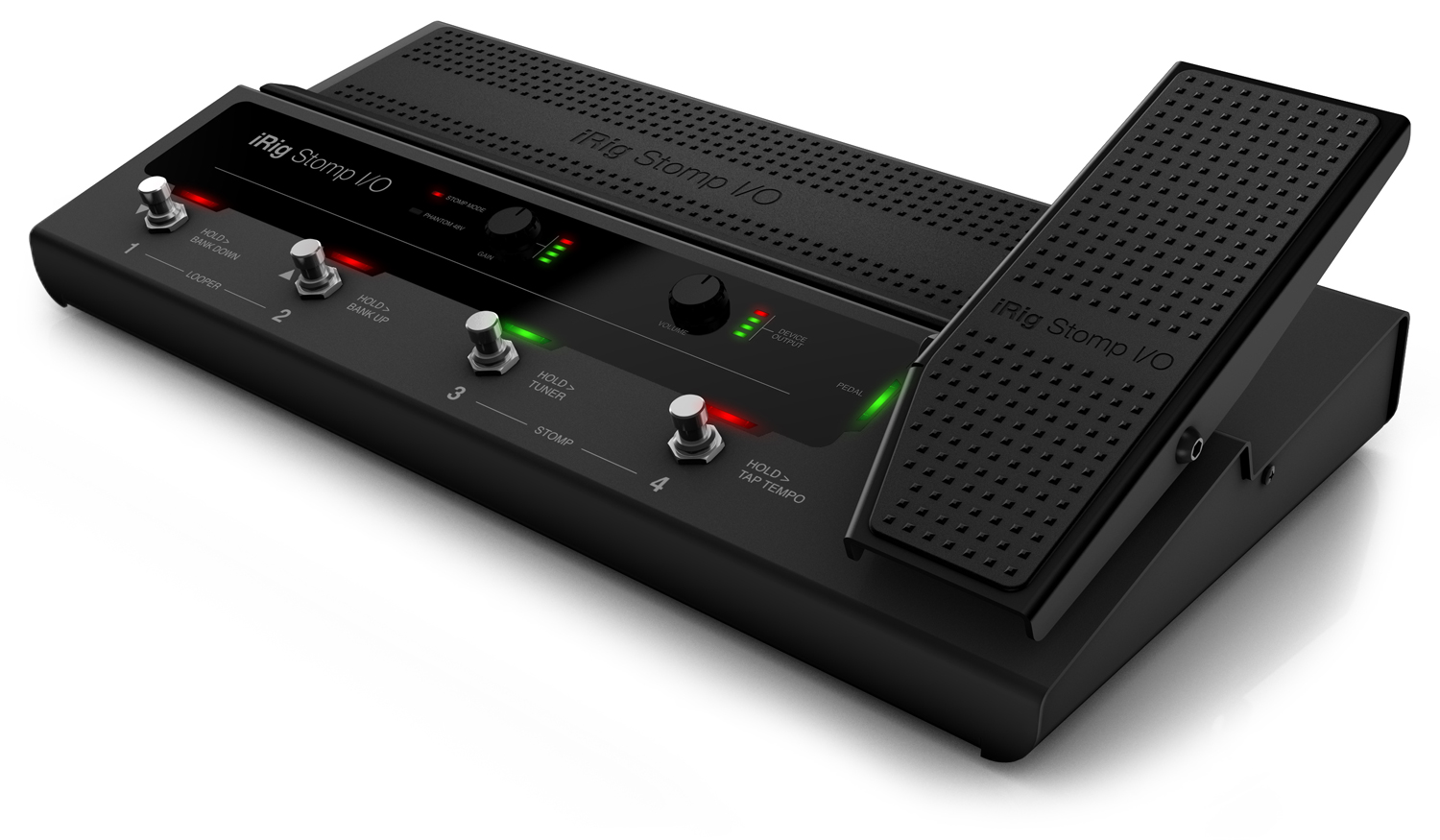
Four footswitches, an expression pedal, sensible I/O, an iPad holder….smart stuff IK!
Line6
Ahh Line 6, another pioneering company. My first brush with them was doing a Rob Halford album in the 90’s and we had received two of those crazy little POD beans to use on the session. Shrapnel’s Derek Taylor proceeded to wail 4 thousand notes per second all over these things, and it was a really really fast and easy way to get song ideas down before anyone could forget them.
Line 6 is really forward thinking and usually has a whole bunch of new ideas every time you run into them. They revolutionized a lot of ways of dealing with sound and especially controlling those sounds.
However, they often do really dumb things, like not putting a line out on the Amplifi 150…Not sure if I’ll ever let them live that down…and it worries me that in an already sketchy environment, they might have messed up on their iOS interfaces. But maybe not, I don’t know as of yet.
The Sonicport looks good, lightning interface, no batteries needed, no gain controls (not sure if that’s good or bad, but after using duct tape to hold my position on the iRig 2’s gain control, could be a good thing), a stereo output on 1/4″ TRS and a headphone output on 1/8″.
I read a lot on forums about low output gain, but I haven’t seen any actual numbers to back that up (hint hint….come on, manufacturers and forum posters alike, its really not that hard to at least give some relative numbers! Plug your guitar into a DI in your DAW, look at the levels, then plug the interface out into that same DI, plug your guitar into the interface and see what you get!)

There is also a Sonic Port VX version that adds a microphone (!) and some sort of pass through charging, though I couldn’t find much info on this last feature.
The Verdict: This could really be a great device! I thought I would have one by now, but no luck, if anyone wants to send me one, I will gladly put it through its paces! Line 6, if you are listening, send me one of these, and please, for the love of The Flying Spaghetti Monster, put a $%#^#^$^ line out on the Amplifi 150!
Melo Audio
Tone Shifter 3/ Tone Shifter 3s
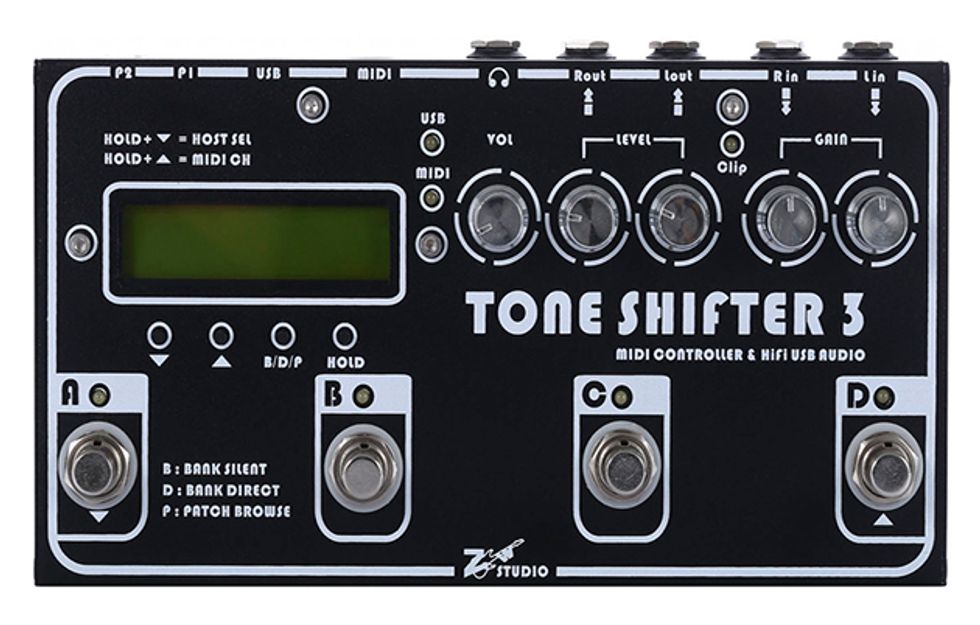
Apparently audio I/O and MIDI switches, could be very cool, but I have an extremely hard time finding info on it.
This interface seemed to have a kickstarter fund attached to it, but information is scarce for me. The website doesn’t seem to load, but it looks good features wise.
Multiple attempts to contact the manufacturer on social media, websites and kickstarter have failed, so until I hear more, as cool as this thing looks, I have no idea how to try one.
Presonus
Audiobox iOne/ Audiobox iTwo

I love it when a manufacturer puts up clear pictures of all the gozintas and gozoutas of a device! Makes things much easier to judge at a glance and understand the claims made in the ads.
Similar to the Focusrite iTrack Solo, and isn’t it always what you would expect, these two guys always vying for the same niche of the same markets, one with the weight of their historical name and the other with sheer pluck and resourcefulness (Presonus I forgive you for ever using the dreaded DICE II chipset on some of your firewire interfaces, as Focusrite did the exact same %^&$& thing!)
Unlike the iTrack Solo however, this unit has actual 1/4″ outs! Yes, thank you! Claiming a +10 dBU output, and also, like the iTrack Solo, can work as a computer audio interface (hopefully with Presonus’ decent ASIO drivers).
The iOne requires power over USB and can pass thru charge your iDevice.
The Verdict: If more of a desktop style is OK for you, this unit should be more than great. Not quite as portable as the lightning powered units.
Sonoma Wire Works
I haven’t tried either of these yet, but they look very promising!
Update: In the initial testing stages of the StudioJack Mini, see below
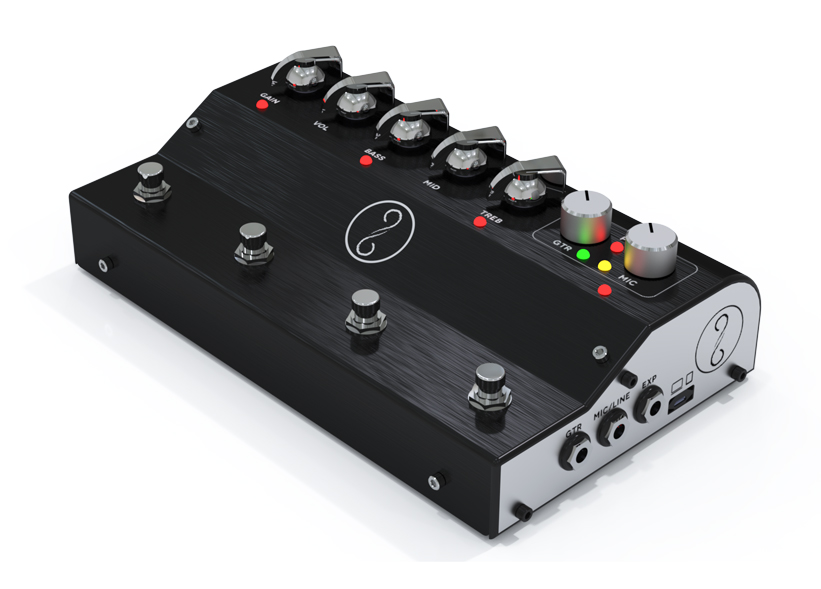
This looks to be quite a serious piece of gear! MIDI pedals, MIDI knobs, plenty of I/O and an expression pedal input!
Pass thru charging! And without any sort of special adapter apparently.
Separate left and right 1/4″ Line outs
1/4″ Stereo headphone out
This is another device that is able to be used as an audio interface for the desktop, and ASIO drivers for it are available.
Like a few other devices in this roundup, the GuitarJack Stage also has a mic input, I don’t bring this up much as its not so relevant to the specific use I intend for them, but know that its there, and even has its own, actual, real, physical, knob to control gain.
I even read a few different reviews and forum posts that said this unit could work alongside IK Multimedia’s BlueBoard bluetooth MIDI controller, who’s achilles heel has been the inability to add more switches to it. I need to test this claim still.
Claims:
- Maximum output level (into 32 Ohms): 1.09 Vrms (34 mW) [my calculations say 2.97 dBu]
- Maximum output level (into 10 kOhms): 1.00 Vrms (+2.2 dBu)
Not sure why this claim is so much lower than the StudioJack Mini below. I have asked the manufacturer, awaiting response.
Really good sign, in less than a day, Sonoma Wire Works explained why the numbers should be as claimed. I will never stop believing that a big part of REAPER’s success is that we would do everything in our power to help the users, even if it meant driving the old:

across the country! A responsive developer like this is a very good sign indeed.
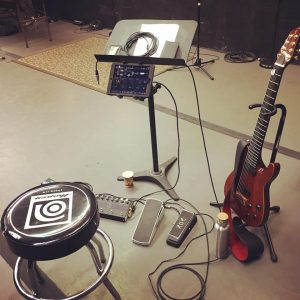
Erik Klerk’s GuitarJack Stage setup. Note the, apparently, Radial DI for the PA output. Sonoma Wire Works definitely recommends NOT putting phantom power into this thing, and anyway, you need to get the levels sensible as the outputs are line level, and unlike so many of the other devices, are claimed to be capable of desktop interface levels of output gain. Note also the expression pedal input, the REALLY long cable from the GuitarJackStage to the iPad, and what seems to be BIAS FX
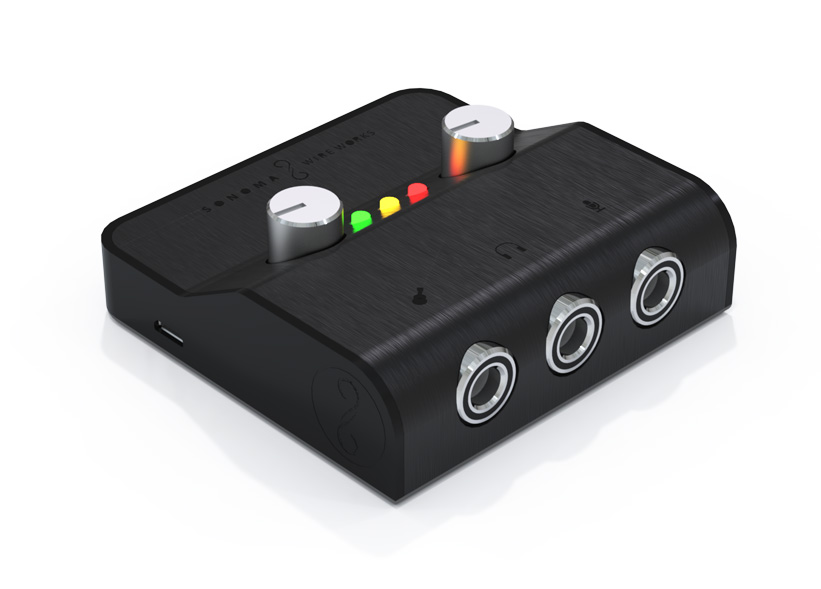
Pass thru charging!
Stereo 1/4″ output
Like the GuitarJack Stage, this unit can also function as an audio interface for the desktop and has ASIO drivers.
Claims (now verified!)
- Maximum output level (into 32 Ohms): 1.09 Vrms (34 mW) [my calculations say 2.97 dBu]
- Maximum output level (into 10 kOhms): 1.73 Vrms (+7.0 dBu)
“The Vrms specs on our site are accurate, but I did some fresh Vpp measurements so you can compare. I got out my Fluke 289 multimeter, a Telecaster, and the StudioJack Mini plugged into an iPhone 6, no external power. Using the the Peak voltage measurement feature on the Fluke, the output of a solid strum across the open strings with the Bridge pickup on the Tele is ~2.5Vpp (it’s got some pretty hot pickups:) Plugging the Tele into the StudioJack Mini and setting the input level to just before the LED turns red (about halfway on the input knob), GuitarTone app running on iPhone, but with all the amps and effects bypassed, so basically just a pass through, with a similar strum yields a similar ~2.5Vpp output. Running a Signal Generator app, with a 1kHz sine wave with full output level I measure ~3.6Vpp. Changing to a GuitarJack Stage gives similar results. So yes it is definitely possible, and our devices both do it without external power. Of course, add the external power, and you get the pass-through charging for your iPhone or iPad:) We run them for 10 hours a day, all week at NAMM. We had to have twice as many iPads as demo stations at shows before we added charging. It was our number one feature request for GuitarJack Model 2, and it tool a lot of work to get right. A lot of this is thanks to Joe Bryan”
THAT is the kind of tech support you’d expect from a company that wanted to stay alive in the desktop world, but is so sadly lacking in the iOS world. This is what you should DEMAND, without question, from the other iOS based companies. MEGA kudos to Sonoma Wire Works.
Hopefully I’ll be trying these sooner rather than later.
Update: Got one on order stay tuned!
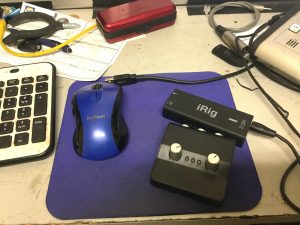
If the products themselves live up to the excellent customer care standards SWW have already shown, I think these devices will be the top of the heap.
After quite a bit of testing I can verify the level claims, this thing is SERIOUSLY legit! The included cables are nice and long, no worried about having to tweak them into suicidally crazy bends in order to hook it up to your iDevice. The multi colored level LEDS on the top of the unit are very handy, a cool feature that some of the iRigs and the Apogees have as well. I found this unit to have plenty of level, no silly noises, and even next to my computer, had very good noise rejection (below the noise level of my guitar). I know I harp on it a lot, but again, the output level was more than high enough to make my amp’s FX loop happy.
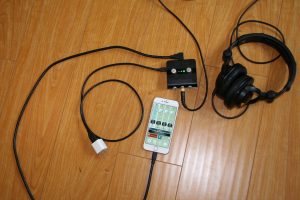 A real good look at just how small this thing is. If you were worried by the pictures on the website thinking this was quite a bit larger than the conveniently pocketsized IK iRig devices, fear not. Yet somehow it still has the space for charging and real 1/4″ jacks
A real good look at just how small this thing is. If you were worried by the pictures on the website thinking this was quite a bit larger than the conveniently pocketsized IK iRig devices, fear not. Yet somehow it still has the space for charging and real 1/4″ jacks
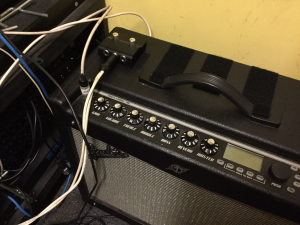
My live and testing setup. StudioJack Mini velcroed to the top of the amp and velcro for my iPad’s case. The Fender Mustang III V2 is pretty handy for this. I have my software’s right signal path including a cabinet simulator, while the left signal path contains no cabinet emulation. If you switch the Mustang’s FX Loop return to “Looper Pedal” setting, the FX return is the only signal path before the volume knob that goes to the speakers. The real speaker does the cabinet sound, since, well, its a speaker in a cabinet! Plugging into here breaks the path from the main guitar input to the speakers. The main input goes thru the regular preamp section, where I have bypassed anything that could be bypassed and set anything else flat. The right signal with the cabinet emulator goes in here, and it goes out to the Mustang’s line level XLR outputs. This way, the soundguy gets the cab sim signal for the PA, without needing a direct box, and the amplifier’s speaker gets the signal it wants! Perfect! Till I get my hands on an FRFR setup anyway
In Conclusion
For a modern lightning device, staying as wireless as possible, the Line 6 Sonic Port, possibly the IK Multimedia iRig HD 2 (though I still have GRAVE concerns about the level issues and some questionable non confidence in their tech support) seem like good choices. But to me , the Sonoma Wire Works StudioJack Mini pulls far, far ahead in this category. The IK Multimedia iRig Pro I/O and iRig Pro Duo could possibly fit into this category as well, I need to find out more about their power situation and output levels.
For a modern lightning device where you don’t mind cables running across the floor, the Focusrite iTrack Dock looks to be an extremely solid contender, with its mass of I/O’s and pass through charging and general Focusrite reliability. However, not to sound like a fanboy, the Sonoma Wire Works GuitarJack Stage looks to absolutely wipe the floor with the competition. If it lives up to its claims, it would seem to dominate this particular category without even an inkling of taking prisoners.
And Finally
As always, I am FOREVER on the lookout for programmers, especially ones that speak C++. I believe my track record of successful audio engineering software should be an encouragement for any coder looking to get into this stuff and we can do some AWESOME work together, let’s go guys!!!
I get a lot lot lot lot of requests and questions about this or that gear, but as some of you know, I make very little money in real life, and any time a windfall shows up, I just end up buying fun stuff for our kids at Kailua Music School, so I have near zero funds to buy and try this stuff. I don’t know if I could set up an easier to use testing donation fund (thanks millions by the way for the stuff so far, everyone reading this is benefiting from your contribution!). Probably the best thing to do at the moment is either send me the things, or ask any manufacturer in question to send it to:
Kailua Music School
131 Hekili Street Suite: 209
Kailua, HI 96734

If you like the kind of stuff I’m doing here, please consider buying some vintage REAPER shirts at my spreadshirt store. https://shop.spreadshirt.com/pipelineaudio/


! am running a Bais mini guitar amp into 4×12 cab for live set up. I want to add bias fx2 pro to my live rig i have an ipad air am in need of an interface for live with out latency issues
will sonoma wireworks jack mini work
Well they all have latency, I think in the end the SJM measured 14msec RTL with Bias FX, I cant remember the exact number, but I have them all listed somewhere. It was the lowest RTL of any device I was able to test
How much latency does the iRig HD 2 have? Thanks!
I did a test where I posted results to the Positive grid forum, I think the lowest I could get thru audiobuss 3 with the iRig 2 was 21 miliseconds round trip latency
This was an incredibly thorough, great review. Thanks so much. Down to either the iRig Pro or studiojack mini for me, I think.
I’m split on the Apogee Jam+ And the Irig HD 2. I plan on running it through my IPhone. Have you had a chance to look at the Jam+? Which one would you suggest?
WHile I have my problems with the iRig2, the Jam really didn’t seem to be understanding modern use of the mobile devices to me.